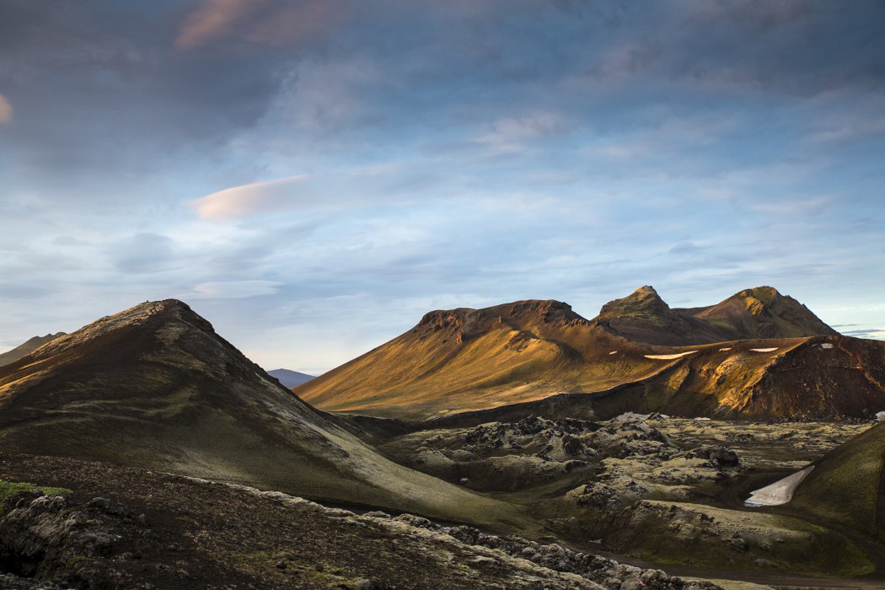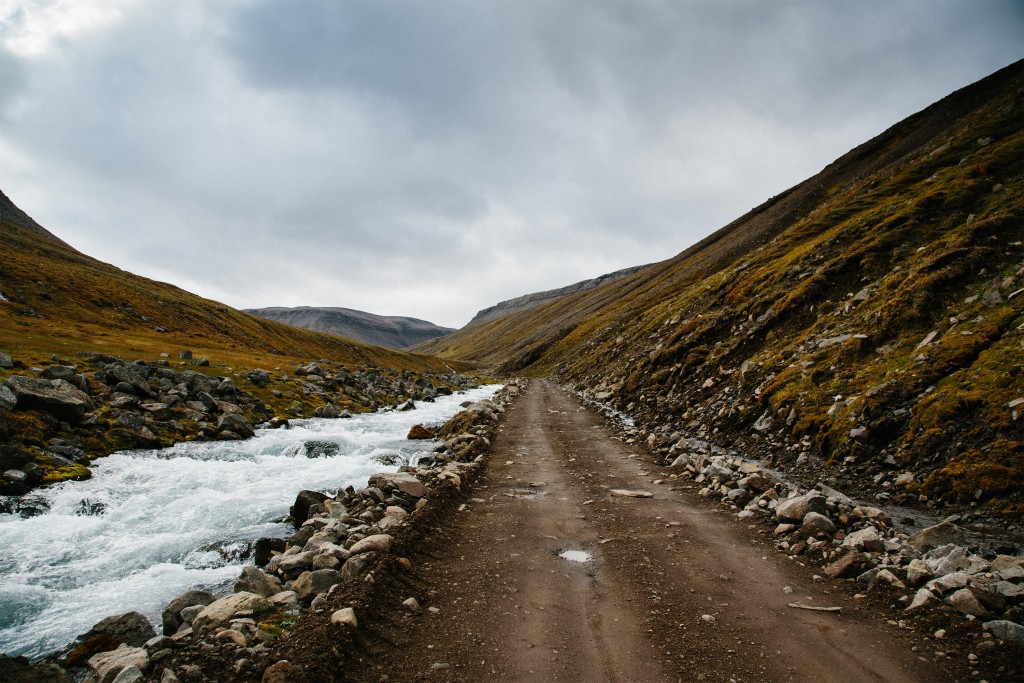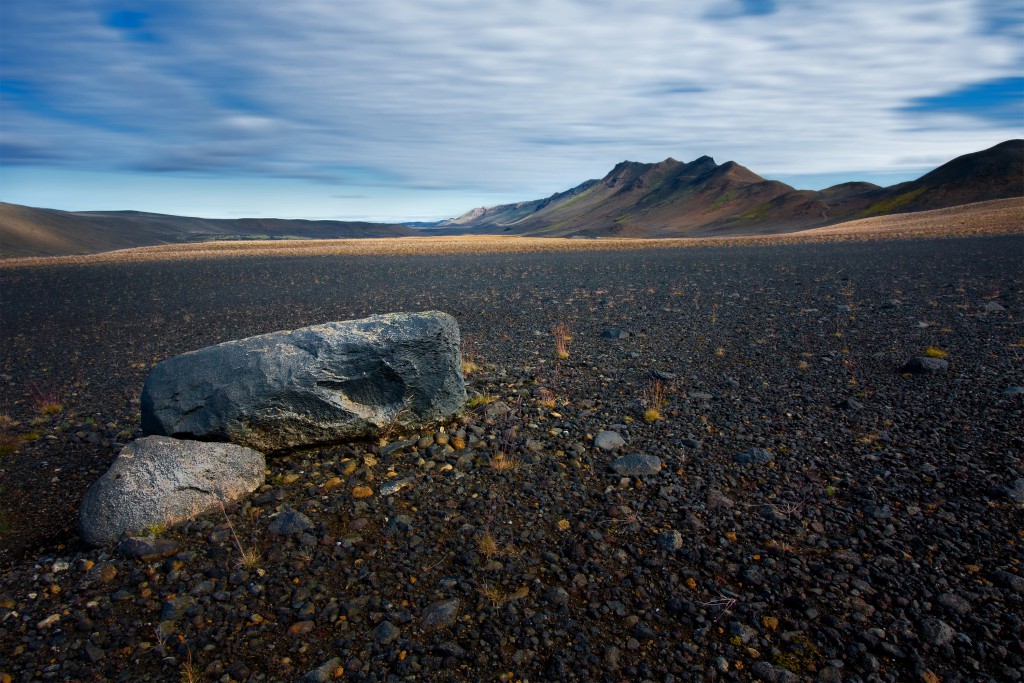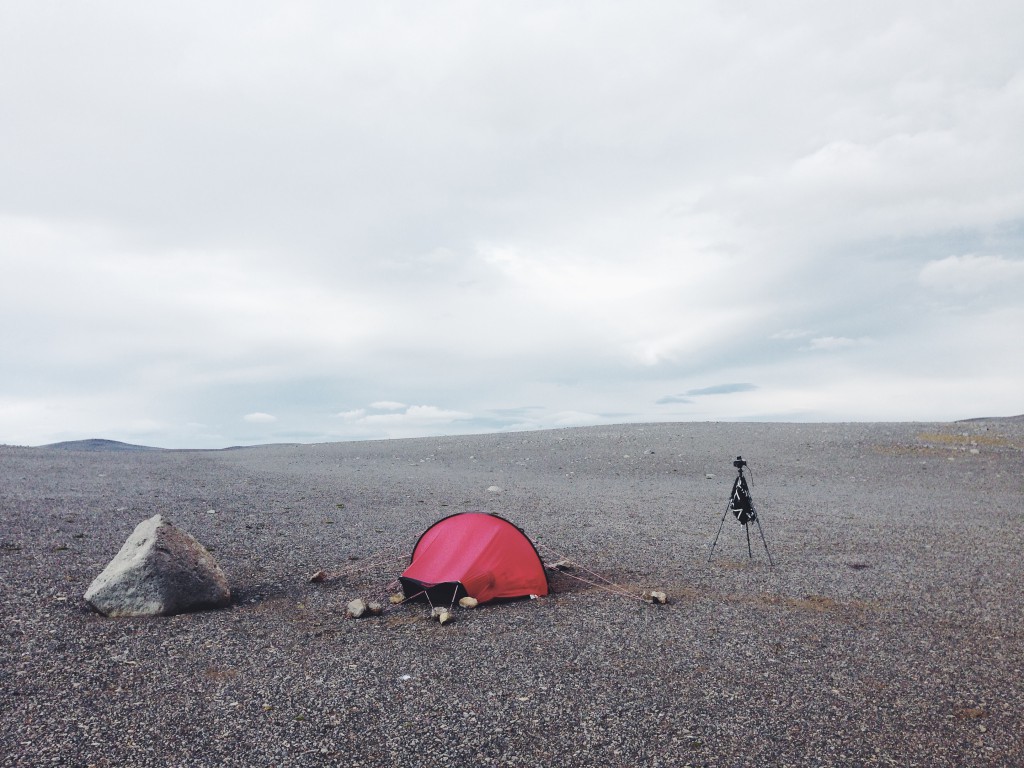In Cold Pursuit
The walls of my dust-covered tent shook like a toy lost in the desolate landscape, while winds screamed like an angry dragon across endless black sands. The shriek brewed with my feelings of fear and loneliness, born from extreme isolation in Europe’s largest desert.

This disastrous concoction diminished my hopes of sleep until the sun crested above sandy dunes and the wild winds dissipated into a mere breeze. At 65 degrees north and 18 degrees west of nowhere, this was no tropical holiday. But despite the 24-hour daylight, I was more thankful than ever for my trusty red tent: my refuge in the cold, black and hollow heart of Iceland.
The geographic centre of this small island country is a theoretical point located in the middle of the infamous highland desert. It had taken numerous adventures in the weeks leading up to this moment, both on four wheels and two, to find this empty moonscape where volcanic rocks, ash and sand spread beyond the horizon in every direction.

The beauty of Iceland is no secret: the destination is known for its abundance of cascading waterfalls, bright moss-laden mountains and towering geysers. However, what I find most fascinating is the desolate, minimalist terrain of the central highlands, a place that tourists tend to avoid and locals drive past. I couldn’t ignore the spirit of the desert, calling me to the highlands. I felt there was more to see, more to experience, if only I stopped and inhabited the space with open eyes and intrigue, rather than naively riding through. I was on a search for the true essence and beauty of Iceland.
To experience the land’s climatic and environmental tensions, I sought a place to settle within the isolated and raw highlands, where I could conduct an exploration into the relationship between Iceland’s melting ice and the black desert that lies in its wake. I began my search for ice by poring over maps, looking for a geographically significant point from which I could conduct my study over a number of days. Was it possible to choose a single destination from which to inhabit Europe’s largest desert? I discovered the geographic centre of Iceland sat within the very middle of the highlands.
Despite being characterised as one of the largest uninhabited regions in Europe south of the Arctic circle, the Icelandic highlands were once traversed on horseback by only the bravest of men. Their route, and mine, was the lengthy Sprengisandur, an ancient pass that slices through the middle of the desert and connects the north and south coasts. The Sprengisandur route is characterised by a seemingly never-ending path through a foreboding interior desert, which is famous in Icelandic history.
For hundreds of kilometres, the stark plains of rocks, ash and sand starved horses of fodder and humans of shelter as monstrous winds whipped the landscape. These features gifted the area its name, which is derived from the Icelandic noun sandur, which means ‘ash deserts of the centre of the island’. The verb sprengja denotes ‘to ride a horse to death,’ or ‘to be on the point of bursting after running for too long’. A daunting proposition.

It wasn’t just the harsh climate and landscape or the infinite bleakness that made the Sprengisandur such an undesirable route. According to Icelandic legend, ghosts, giants, elves and outlaws roamed the sands. Consequently, the highlands were avoided as both a place to inhabit and travel through. So if crossing them was necessary, the traveller would ride as hard and fast as possible in order to exit this unruly place into civilisation before running out of provisions or encountering foe, supernatural or otherwise.
Visions of giants, ghosts and exhausted horses filled my mind as I rode not a horse, but a jittering old bus to within a few kilometres of the geographic centre. As I gazed out the dusty windows, lush grass fields, vibrant flowers and gushing rivers transitioned before my eyes into a wild amalgamation of rocks, ash and sand underneath the sad sky. Plummeting further into the windswept and rain-saturated highlands, I understood at once why most people never enter, let alone settle in such a hostile environment.
Hours passed as the driver wrestled the bus across the highland desert, swerving to avoid large potholes and wheel-breaking rocks. Then, suddenly, the bus came to a halt. Mutters of confusion arose amongst the passengers as I gathered my bags and leapt off into the unknown. Abandoned on the side of the road, I watched the bus disappear across the sand in a mighty cloud of dust. I had almost arrived at my destination in the middle of nowhere, but had a lonely walk ahead until I reached the real centre.
I decided to split my trek into two stages. The first would be somewhat of a recon mission, leaving my big heavy pack at the river. As I walked out across the landscape, GPS in hand, the true force of the wind and depth of the sand hit me. My pace was immediately slow as I trudged, one foot in front of the other, heels sinking into the black earth and head bowed to embrace the oncoming southerly. One glacial river sliced its way through the black vista, providing a welcome, albeit freezing break. I trekked the undulating Icelandic desert for an hour before my GPS clicked over to 65 degrees north and 18 degrees west. I looked up and grinned, having found what I was searching for. There was nothing there: only me, nestled with the sand, wind and sky.

I was standing in complete isolation, feeling as if I was the first to set foot on this land. The dark desert met the bright sky with such elegance. The wind howled, the sand stung and my heart beat with excitement. I was enveloped in a world where thunder transitions into incredible silence, where the earth fuses into the sky like a majestic Rothko painting, where light seeps into pure darkness. The geographic centre was bleak, wild, ferocious, yet incredibly beautiful and intriguing. I began studying the details in the sand, the interaction between the incredibly kinetic sky and equally powerful static ground. As I cleared rocks to form a flat site to set up my tent, huge clouds brushed shadows between which pockets of light filtered across the desertscape. I felt very small in what was to be my new home for the next 5 days.

As the extent of my remoteness set in, I made my way back to the road to collect my pack and extra food. Then came an even slower and more painful journey back to the centre. It was 4 hours before all my gear was in one place and my tiny one-man tent was set up, anchored to the earth only by a collection of rocks. Standing back to assess the stability of my modest refuge, I realised the power of shelter and how much we take it for granted. In this case, my tent wasn’t just my retreat from the harsh Icelandic elements, it was a bright red beacon in the barren landscape. Apart from the blue sky, it was the only piece of colour in my now monochromatic environment.

For the next few days, my simple life at the geographic centre consisted of reading, eating and sleeping, in between periodic excursions out onto soft, dark sand. I would lie in my tent reading about others’ adventures in harsh environments, occasionally glancing away from the page to watch the clouds gently wisp across the sky, their shadows trailing behind them across the sands. Slowly the sun would dip towards the crisp horizon, causing the dark sand and rocks to glisten and shimmer.
On the odd occasion, the winds would cease altogether and I would perch myself against the outside of the tent to experience the completely silent landscape. No wind, no birds, no traffic, no people, no life — nothing. During these times, the silence was so extreme I could hear the blood in my head pumping. These were rare but incredibly profound moments.
When patters of rain fell, I took shelter in my little red retreat. Water cascaded down the fly to be absorbed back into the earth. The steam from my freshly brewed coffee fogged up my glasses, but warmed my now-freezing hands. Finally, the rain began to ease, and a moment of calm approached. It was like the Earth took a breath, a pause before the imminent heavy rain I could see forming in the horizon.
With a burst of energy, I headed out west into uncharted territory. Trudging across the sand, my path intersected with numerous other tracks striking off in different directions. All of these were my own footsteps, a record of precious journeys and wanderings across the sands. Many of the footsteps I did not recall making. However, this path felt different. Something in this direction was pulling me forward as the wind picked up and light rain dirtied my glasses.
Cresting over yet another mound of sharp volcanic rocks and gritty sand, my mind was blown by what lay in front of me. In this rugged moonscape sat quietly a valley of pristine white ice. Within the valley lay large dormant chunks, melting slowly into a stream striking through the dark sand. Was it the ruins of a glacier? Or remnants of last winter’s snowfall, still frozen in the unbearably cold air? The ice’s past was unknown to me. But what I did know was that my search for ice — my search for a hidden treasure at the centre of Iceland —was over.

The source of the magnetic force that pulled me to this location in the desert had revealed itself. With the light fading and weather closing in every minute, I descended the steep, rocky slope into the valley. My hand touched the ice as I clambered up onto its sculpted surface — a sudden, yet powerful introduction. I was surprised at how foreign the ice felt in this landscape. Second by second it melted, as I traversed its surface with a delicate foot and sympathetic eye. This tiny portion of gleaming white tells a story about Iceland’s past and its future.
Iceland’s precious ice caps and glaciers cover just 10 per cent of the country and, according to geoscientist Kathleen Compton, are losing an average of 9.5 billion tonnes of ice a year. In fact, the annual volume of ice lost and not replaced with new snow would fill 50 of the world’s largest trucks every minute for an entire year. However, what is even more shocking is that despite the high volcanic activity in Iceland, 95 per cent of the melting can be attributed to global warming, making Iceland one of the fastest-warming countries on the planet.
The permanent loss of some of Iceland’s glaciers has already occurred, with many more up for extinction in the near future. Without their nation’s eponymous element, Icelanders can’t harness power from glacial rivers or tap into glacial ice stores. Ice is part of life in Iceland — it’s imbued into the country’s soul and those of its occupants. That is what makes this pocket of ice I found at the geographic centre so precious, no matter what its origin. It is symbolic of the relationship between the reduced ice and expanding desert, and emphasises the enigmatic and isolated qualities of Iceland’s remaining glaciers and ice caps.
